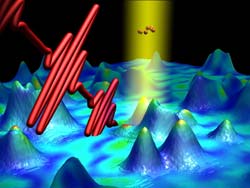High-tech microscope measures electron oscillations

Ultra-short laser pulses (red) are used to measure electron oscillations (red balls) at the surface of a nano-structure. Image: Walter Pfeiffer, Bielefeld University<br>
The new technology allows tracking extremely fast processes in miniature objects – with an unparalleled spatial and temporal resolution. “For the first time we were able to determine the duration of electron oscillations in a single nano structure”, says Professor Tobias Brixner of the Institute for Physical and Theoretical Chemistry of the University of Würzburg.
The analyses have shown that the collective electron movement after exciting a silver nano structure with light lasts up to 20 times longer in certain places than was thought. The duration of electron oscillations is of interest not only for basic research. It also has a significant influence on the efficiency of energy transport processes as occur, for instance, in photovoltaic cells or during the photosynthesis of plants.
“Our new method will allow us in the future to track very fast processes in many natural and artificial nano-structured materials”, the scientists explain.
The research team and its sponsors
The teams of Professor Martin Aeschlimann (Kaiserslautern), Tobias Brixner (Würzburg) and Walter Pfeiffer (Bielefeld) presented their new analysis method on 11 August 2011 in the internationally renowned “Science” magazine that can be read online at http://www.sciencexpress.org. The German research association (DFG) has supported the project of the three research teams within the scope of its priority program “Ultrafast Nano-Optics”.
Electron microscopy combined with laser flashes
How did the cooperation partners accomplish this success? They combined the advantages of an electron microscope with the excitation of ultra-short laser flashes and the high time resolution that can be achieved by this. This enables them to detect structures ten times smaller than would be possible using optical microscopes. The progress of the object properties can thus be followed with the extremely high time resolution of a few femtoseconds – an inconceivably short period of time during which a jet plane travels a distance smaller than the diameter of an atom”, as Professor Brixner compares.
In order to be able to track ultrafast processes in the microcosm, the researchers use a complex sequence of ultra-short laser pulses which experts refer to as “coherent two-dimensional nanoscopy”. The physicists and physical chemists finally accomplished their goal by developing a new sequence of laser pulses and the proof of the electrons emitted in this process.
„Coherent Two-Dimensional Nanoscopy“, Martin Aeschlimann, Tobias Brixner, Alexander Fischer, Christian Kramer, Pascal Melchior, Walter Pfeiffer, Christian Schneider, Christian Strüber, Philip Tuchscherer, Dmitri V. Voronine, Science, August 11, 2011, DOI 10.1126/science.1209206
Contact
Prof. Dr. Tobias Brixner, University of Würzburg, T +49 (0)931 31-86330, brixner@phys-chemie.uni-wuerzburg.de
Prof. Dr. Martin Aeschlimann, University of Kaiserslautern, T +49 (0)631 205-2322, ma@physik.uni-kl.de
Prof. Dr. Walter Pfeiffer, University of Bielefeld, T +49 (0)521 106-6908, pfeiffer@physik.uni-bielefeld.de
Media Contact
All latest news from the category: Physics and Astronomy
This area deals with the fundamental laws and building blocks of nature and how they interact, the properties and the behavior of matter, and research into space and time and their structures.
innovations-report provides in-depth reports and articles on subjects such as astrophysics, laser technologies, nuclear, quantum, particle and solid-state physics, nanotechnologies, planetary research and findings (Mars, Venus) and developments related to the Hubble Telescope.
Newest articles

High-energy-density aqueous battery based on halogen multi-electron transfer
Traditional non-aqueous lithium-ion batteries have a high energy density, but their safety is compromised due to the flammable organic electrolytes they utilize. Aqueous batteries use water as the solvent for…

First-ever combined heart pump and pig kidney transplant
…gives new hope to patient with terminal illness. Surgeons at NYU Langone Health performed the first-ever combined mechanical heart pump and gene-edited pig kidney transplant surgery in a 54-year-old woman…

Biophysics: Testing how well biomarkers work
LMU researchers have developed a method to determine how reliably target proteins can be labeled using super-resolution fluorescence microscopy. Modern microscopy techniques make it possible to examine the inner workings…





















